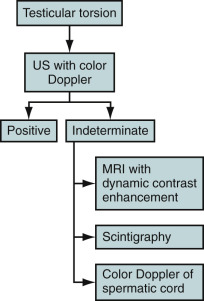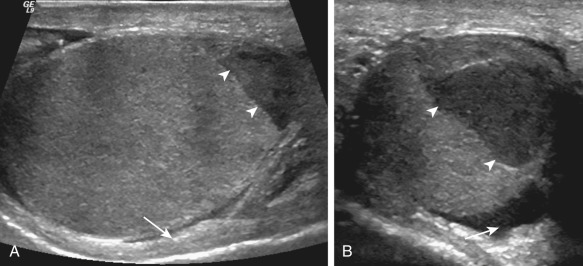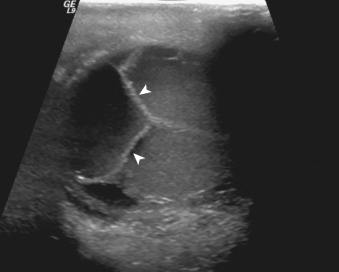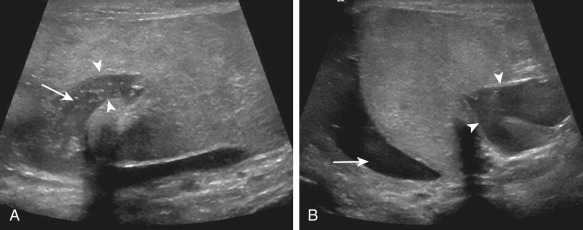Physical Address
304 North Cardinal St.
Dorchester Center, MA 02124
Benign scrotal or testicular swellings and masses have many etiologies and different clinical presentations, as listed in Tables 78-1 and 78-2 . Of palpable nodules, 31% to 47% are benign at surgery.
| Condition | Symptoms | Signs | Comments |
|---|---|---|---|
| Torsion | Acute onset of severe pain, usually postpubertal | Pain not relieved by scrotal elevation, high-riding testis, absent cremasteric reflex | Surgical emergency |
| Epididymo-orchitis | Severe acute onset of pain, older age group | Edema, tenderness, erythema | Positive urinalysis |
| Torsion of appendix testis | Gradual onset of pain, usually prepubertal | Tenderness localized to anterosuperior testis, cremasteric reflex preserved | Managed conservatively |
| Trauma | History of injury | Depends on severity of injury | May result in infarction, rupture, or torsion of testis. |
| Infarction | Depends on cause | Not specific | Possible causes include torsion, epididymo-orchitis, vasculitis, hypercoagulable states, sickle cell disease. |
| Abscess | Pain, fever, failure to improve with antibiotics in case of abscess secondary to epididymo-orchitis | Febrile; tender, swollen scrotum Signs may be masked in patients with acquired immunodeficiency syndrome |
Known complication of mumps, smallpox, scarlet fever, influenza, typhoid, and sinusitis. Fournier's gangrene may extend to involve the testis. |
| Hematocele/pyocele | Depends on cause | Edematous and swollen in the acute phase, scrotal skin thickening, calcification when chronic | Hematoceles occur after trauma, including iatrogenic trauma. Pyoceles form from rupture of an abscess into, or infection of, a hydrocele. |
| Incarcerated inguinal hernia | Sudden irreducibility of inguinal hernia with pain | Nonreducible, edematous, red inguinal mass | Usually presents in the setting of a preexisting inguinal hernia. |
| Condition | Symptoms | Signs | Comments |
|---|---|---|---|
| Hydrocele | Painless mass that may increase slowly in size | Transillumination positive | Reactive hydrocele may be associated with epididymo-orchitis or other inflammation. |
| Testicular cyst | None | Usually nonpalpable | Incidental finding on ultrasonography. |
| Varicocele | Scrotal swelling, infertility | More common on the left; “bag of worms” feel on palpation, pronounced on Valsalva maneuver | Sudden onset of a right-sided varicocele, or any irreducible varicocele, may be due to retroperitoneal pathology (e.g., renal cell carcinoma) compressing the testicular vein. |
| Epidermoid cyst | Painless mass or none | Palpable mass or none | Often removed surgically because it may be difficult to differentiate from malignancy. |
| Tubular ectasia of rete testis | None | None | Incidentally discovered; may be associated with prior infection, trauma, or scrotal surgery |
| Adrenal rests | Often manifest as bilateral scrotal swelling | Bilateral scrotal masses | Usually associated with elevated corticotropin level |
| Spermatocele | Asymptomatic or may manifest as small focal scrotal lump | Discrete soft mass near epididymis, freely moving and superior to testis with positive transillumination | Arises from obstructed efferent ductules usually in patients with prior vasectomy. |
| Testicular microlithiasis | Asymptomatic | None | Incidental diagnosis, may be premalignant, follow-up imaging is often advised. |
| Scrotal pearl | Asymptomatic or may manifest as nodular swelling | Hard nodule may or may not be felt. | Generally idiopathic and benign; may be from a torsed appendix testis. |
Testicular torsion occurs when the spermatic cord is twisted, compromising the blood flow to and from the testis. Torsion can be classified as intravaginal or extravaginal. Intravaginal torsion occurs when the mesenteric attachment of the spermatic cord on the testis is narrow, allowing the testis to rotate within the cavity of the tunica vaginalis like a “bell clapper.” It typically affects males between the ages of 12 and 18 years, probably owing to the fivefold increase in testicular volume at puberty. Extravaginal torsion, in which the entire testis, epididymis, and tunica vaginalis twist in a vertical axis, is rare and is typically seen prenatally (75%) or in neonates. Intravaginal torsion is characterized by pain of sudden or insidious onset, whereas extravaginal or neonatal torsion may be completely asymptomatic, and a unilateral mass in the inguinal region or high scrotum may be the only manifestation. The extent of the spermatic cord twist and its duration are the two most important factors. The initial disruption of blood supply will be to the venous and lymphatic drainage, rather than to the arterial supply of the testes, and venous infarction occurs earlier and at lesser levels of torsion.
Magnetic resonance imaging (MRI) has been used to differentiate subacute testicular torsion from epididymitis with a high degree of accuracy. On MRI, an enlarged spermatic cord (secondary to edema) with no increase in cord vascularity (seen as lack of vascular flow voids) and a “whirlpool pattern” and “torsion knot” (best seen on T2-weighted coronal views) are specific for torsion.
Contrast-enhanced MRI can help in the diagnosis of segmental testicular infarction ( Figure 78-1 ). Dynamic contrast-enhanced subtraction MRI can diagnose testicular torsion and detect testicular necrosis with a high degree of sensitivity and accuracy.

On ultrasonography, the initial appearance of the testis is hypoechoic and enlarged secondary to congestion accompanied by a small hydrocele. Later, increased echogenicity and heterogeneity can be seen from hemorrhagic change. The epididymis also may be involved ( Figure 78-2 ). A small hypoechoic testis, with an enlarged echogenic epididymis, is seen with a chronic missed torsion. There may be an abrupt change in caliber of the spermatic cord below the point of torsion. Ultrasound demonstration of the “whirlpool” sign in the spermatic cord with absent or reduced flow distal to the whirlpool is a reliable indicator of torsion. Skin thickening may manifest as venous congestion.

Color Doppler imaging allows visualization of intratesticular blood flow, which is either reduced or absent in torsion. This distinction may be less apparent when orchitis is complicated by testicular infarction. Technical factors, including equipment and operator experience, may limit the quality of the study. A useful caveat to use in such conditions is to compare the findings with the contralateral normal testis. Color Doppler flow is difficult to detect in testes less than 1 mL in volume (i.e., in children). Techniques including power Doppler imaging and the use of contrast agents may improve detection of intratesticular flow.
The most common cause of scrotal pain in a young child is torsion of the testicular appendix. The ultrasound appearance of the twisted testicular appendage has been described as an avascular hypoechoic or echogenic mass adjacent to a normally perfused testis and surrounded by an area of increased color Doppler flow.
Traditionally, testicular scintigraphy has been used in the assessment of testicular torsion, but this method suffers from the constraints of limited access out of hours, complex equipment needs, and prolonged examination times.
An imaging algorithm for testicular torsion, adapted from the American College of Radiology Appropriateness Criteria for Acute Scrotal Pain without Antecedent Mass or Trauma is proposed in Figure 78-3 and Table 78-3 .

| Modality | Accuracy | Limitations | Pitfalls |
|---|---|---|---|
| MRI | 93%-100% | Motion sensitive, requires more time to perform than ultrasonography, skill to interpret, relatively expensive | T2*-weighted images may not be sensitive for detection of late contrast enhancement and are vulnerable to susceptibility artifacts that result from the air/tissue interface, which may distort images and hamper accurate measurement of signal intensity. |
| Ultrasonography | 89%-100% | Lower sensitivity in prepubertal and younger children | Blood flow can be preserved in torsion and detorsion, when hyperemia can be mistaken for orchitis. |
| Nuclear medicine | 90% sensitivity 60% specificity |
Cannot be applied to small children Lower availability of trained personnel to perform and interpret the examination |
Hyperemic epididymis may be misinterpreted as a halo, producing false-positive study. Photon-deficient areas secondary to hydrocele, spermatocele, uncommonly edematous appendix testis, and rarely an inguinal hernia can be mistaken for an avascular testis. |
Epididymitis is the most common cause of acute scrotal pain in postpubertal men. In 20% of patients, testicular extension results in epididymo-orchitis. Primary orchitis may result from infectious agents such as mumps. Epididymitis in older men usually results from a lower urinary tract infection with the common causative organisms being Escherichia coli, Pseudomonas, and Klebsiella. In younger men, organisms such as Chlamydia and Neisseria gonorrhoeae are more common etiologic agents. Rarely, tuberculosis may cause epididymo-orchitis. Mild repetitive trauma to the scrotum such as caused by riding a bicycle also may cause mild noninfective “mechanical” epididymo-orchitis.
Testicular abscess is usually a complication of epididymo-orchitis, although it may also result from undiagnosed testicular torsion, gangrenous or infected tumor, or primary pyogenic or outcome of primary orchitis. A testicular abscess may complicate into pyocele or a fistula to the skin.
MRI is not used as a primary modality, but epididymo-orchitis may be diagnosed in suspected cases of torsion based on increased vascularity of the spermatic cord, epididymis, and testis.
Ultrasound findings of acute epididymitis include diffuse or focal involvement with low echogenicity or, rarely, high echogenicity (if there is coexisting hemorrhage), and increased blood flow on color Doppler imaging. There is usually evidence of inflammation in the rest of the testis, as well in the form of generalized swelling and hyperemia ( Figure 78-4 ). Associated findings, such as reactive hydrocele or pyocele and scrotal wall edema, can further support the diagnosis. Testicular ischemia and infarction may occur when the vascularity of the testis is compromised by venous occlusion. Changes of chronic epididymo-orchitis include persistent swelling of the epididymis as a heterogeneous mass and a striated appearance of the testis.

Primary orchitis such as that secondary to mumps may have nonspecific findings and mimic tumor and transient torsion/detorsion. However, the presence of increased venous flow suggests orchitis, because intratesticular venous flow is usually difficult to detect in normal testes.
Testicular abscess is most commonly seen as an irregular, hypoechoic to anechoic mass with areas of mixed echogenicity. It is usually distinguished from tumors on the basis of clinical symptoms.
The primary causes of scrotal trauma include blunt, penetrating, degloving, and thermal injuries. Blunt scrotal trauma is by far the most common cause of testicular injury and usually results from athletic injury, motor vehicle accident, or assault. The right testis is more commonly injured than the left. Testicular trauma may result in testicular hematoma, traumatic hydrocele or hematocele, testicular fracture, rupture, and infarction.
MRI is generally not used to evaluate primary testicular trauma, although it may be performed for concomitant penile trauma.
Ultrasonography is ideal for the assessment of scrotal trauma because it provides rapid and accurate assessment of scrotal contents and their integrity. Hematoma may be intratesticular or extratesticular and appear hyperechoic (acutely), heterogeneous (subacute), or predominantly hypoechoic (chronic) ( Figure 78-5 ). Without surgical exploration, intratesticular hematoma has a poor prognosis.

Hydrocele is commonly seen with trauma ( Figure 78-6 ). Simple hydroceles usually appear uniformly hypoechoic. Rupture of the bulbar urethra may result in leakage of urine into the scrotum, mimicking a hydrocele. Hematocele (blood within the tunica vaginalis) also may occur in trauma. Heterogeneity of the testicular parenchyma with associated hematocele suggests testicular rupture.

A testicular fracture is a break in the continuity of the testicular parenchyma with an intact tunica albuginea. A testicular rupture involves discontinuity of the tunica albuginea with extrusion of testicular parenchymal contents into the scrotal sac. Testicular rupture necessitates emergent surgery, whereas testicular fracture with preserved vascularity may be managed conservatively. Testicular fracture without preserved vascularity also necessitates emergent surgery, owing to the presence of testicular ischemia. Heterogeneous testicular parenchymal echotexture, with focal hyperechoic or hypoechoic areas, corresponds to areas of hemorrhage or infarction ( Figure 78-7 ). Contour abnormality is the single most important predictor of testicular rupture.

Become a Clinical Tree membership for Full access and enjoy Unlimited articles
If you are a member. Log in here